|
|
|
Sort Order |
|
|
|
Items / Page
|
|
|
|
|
|
|
| Srl | Item |
| 1 |
ID:
096925
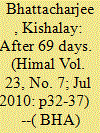

|
|
|
| 2 |
ID:
165194
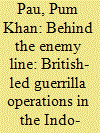

|
|
|
|
|
| Summary/Abstract |
The paper probes the formation of local Levies among the indigenous hill people of the Indo-Burma frontier and their contributions to the British-led guerrilla operations during the Second World War. With the shift of the theatre of the Southeast Asian edition of the Second World War from the Lower Burma plains to the mountainous hilly terrain in the Indo-Burma frontier, the mode of warfare also changed. In the new terrain where conventional warfare was no longer suitable the British Indian Army resorted to guerrilla tactics largely with the support of the indigenous hill people who had the traditional expertise in guerrilla fighting. However, the valour and heroism of the indigenous hill people behind the enemy lines has not received adequate scholarly attention. This paper discusses the case of three ethnic communities in the Indo-Burma frontier – Kachin, Naga and Zo (Kuki-Chin) – who were considered by the British as ‘loyal allies’ at the risk of Japanese atrocities. Supervised by British civil and military officers the local Levies not only effectively bogged down the Japanese forces in the frontier but also supplied valuable intelligence to the Allied force in the reconquest of Burma. The paper argues that Kachin, Zo and Naga rallied behind their colonial masters with the hope that they would receive reward from the latter after the war.
|
|
|
|
|
|
|
|
|
|
|
|
|
|
|
|
| 3 |
ID:
152014
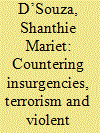

|
|
|
|
|
| Summary/Abstract |
South Asia continues to remains a hotbed of various forms of extremism. Indiscriminate violent terrorism with a strong religious overtone claims the highest number of victims, most notably in Pakistan and India. Islamist Jihadi movements backed by external actors keep the state of Jammu and Kashmir on a boil. Globally inspired Jihad in search of a shariah-ruled state has recurrently raised its head in Bangladesh. Linkages with global jihad and movements that have rallied support to an anti-West platform have escalated their violence potential. They remain a threat not just to the region but have demonstrated an inclination to network with groups having a trans-regional agenda.
|
|
|
|
|
|
|
|
|
|
|
|
|
|
|
|
| 4 |
ID:
180618
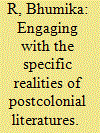

|
|
|
|
|
| Summary/Abstract |
Contemporary Naga literature in English engages with aspects of State-making, nationalism while it lives in a moment identified as the global. It also inhabits the ‘postcolonial’ terrain given its history of British Colonisation. In other words, even as contemporary Naga literature in English engages with features broadly identified as constituting the postcolonial, due to the multiple socio-political realities it inhabits, it also needs to be read in terms of its specificities. Since contemporary Naga literature in English is embedded in multiple realities, locating it within a single theoretical trajectory can be difficult. This paper attempts to demonstrate that while literatures can be mapped as belonging to the ‘postcolonial’ time, it is difficult to map similarities across literary writings, in terms of literary articulation.
|
|
|
|
|
|
|
|
|
|
|
|
|
|
|
|
| 5 |
ID:
119498
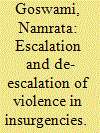

|
|
|
|
|
| Publication |
2013.
|
| Summary/Abstract |
Insurgencies in the Northeast of India have been a recurring phenomenon since India's independence in 1947. One of the most significant aspects of the multiple insurgencies has been the use of violence for political goals. By drawing upon three cases of insurgencies in Northeast India, the article offers a conceptual framework on escalation and de-escalation of violence in insurgencies. The article argues that the most critical variables which have a direct bearing on the levels of insurgent violence are: popular support, loss of legitimacy and the state's counter-response.
|
|
|
|
|
|
|
|
|
|
|
|
|
|
|
|
| 6 |
ID:
157879
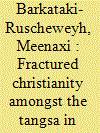

|
|
|
|
|
| Summary/Abstract |
This paper examines the proliferation of Christian denominations among the small Tangsa community in Northeast India. While resentment over the language chosen by the Baptist Church for the official Tangsa Bible triggered the initial fissures, the recent arrival of Pentecostal and charismatic churches has brought about further divisions. These divisions have not helped the cause of pan-Tangsa unity. However, in the everyday lives of most Tangsa, it is the Christian/non-Christian divide that is more relevant. Hence, the Tangsa situation is different from that of the neighbouring Mizo and Naga communities, in which Christianity has become a defining part of their identities.
|
|
|
|
|
|
|
|
|
|
|
|
|
|
|
|
| 7 |
ID:
185504


|
|
|
|
|
| Summary/Abstract |
Frontier tribes, inhabiting the Indo (Naga)-Myanmar border, are at the fringe of the nation-states. They remain outside the radar of connectivity and development. The international boundary line demarcated during the colonial rule, pierces through the middle of many villages. This was reinforced by the post-colonial Indian and Myanmar States, thus deepening the contestation between state and tribal society(s). The Indo (Naga)-Myanmar borderland, elicits the case of nation-state construction as opposed to what Lefebvre posits geographical space, as ‘socially constructed’. The distortion of tribal land and territory in the forms of fencing and securitization amounts to the denial of a tribe’s agency and erasure of their shared history and social relation. The paper charts out the ramification of the colonial state making project in the contemporary frontier tribes. It unfolds the contestation, presence and absence of the state in the borderlands and posits for development with justice.
|
|
|
|
|
|
|
|
|
|
|
|
|
|
|
|
| 8 |
ID:
144690
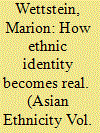

|
|
|
|
|
| Summary/Abstract |
Taking the material and performative world of the Nagas in Northeast India by way of example, this paper examines how identity, above all ‘ethnic’ identity, is manifested and gets incorporated into the understanding that people have of themselves. Following the shifts in identity over time by comparing ritual performances at the turn of the last century with present-day festivals in Nagaland, it is argued that the enactment of identity roles in public performative events provides a mechanism that makes identity concepts such as ‘ethnic identity’ real to people. The liminoid state during the performance enables individuals to live through identity roles emotionally, mentally, and somatically. It is suggested that the enactment of identity roles in public performances can thus be taken as a key to explain why and how identities can shift over time and between contexts.
|
|
|
|
|
|
|
|
|
|
|
|
|
|
|
|
| 9 |
ID:
091489
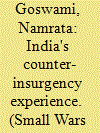

|
|
|
|
|
| Publication |
2009.
|
| Summary/Abstract |
The Indian Army, a force trained primarily for conventional warfare, has been engaged in internal counter-insurgency operations since the 1950s. Despite such a long innings on a counter-insurgency mode, little attention has been accorded within military circles to doctrinal innovation for waging sub-conventional warfare in India's democratic political context. At best, the Army continues to view counter-insurgency duty as secondary to its primary duty of defending India from external conventional threats. By conceptualizing a counter-insurgency strategy of 'trust and nurture', this article aims to fill this critical doctrinal gap in India's military policy. The author argues that a counter-insurgency strategy of 'trust and nurture' based on democratic political culture, measured military methods, special counter-insurgency forces, local social and cultural awareness and an integrative nation-building approach will result in positive handling of India's internal security problems. The author utilizes India's counter-insurgency experiences in Assam, Mizoram, Nagaland, Punjab, and Operation 'Sadhbhavana' in Jammu and Kashmir as illustrative empirical indicants in order to validate the 'trust and nurture' strategy.
|
|
|
|
|
|
|
|
|
|
|
|
|
|
|
|
| 10 |
ID:
092350
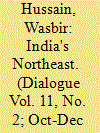

|
|
|
| 11 |
ID:
117929
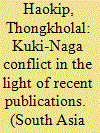

|
|
|
|
|
| Publication |
2013.
|
| Summary/Abstract |
This brief article critically reviews various recent essays and publications on the Kuki-Naga conflict of the 1990s. The conflict has resulted in uprooting hundreds of villages, with the loss of more than a thousand lives, destruction of valuable properties and internal displacement. While British colonial policies of governance in Northeast India and the rise of ethnic nationalism among Kukis and Nagas in the post-independence period have been identified as major root causes of the Kuki-Naga conflict, the literature remains inconclusive and this article argues that today competing claims and perceived threats regarding land and territory appear to be the major cause of continuing tensions.
|
|
|
|
|
|
|
|
|
|
|
|
|
|
|
|
| 12 |
ID:
178052


|
|
|
|
|
| Summary/Abstract |
The paper explores the identity dynamics of a lesser known community by the name Bujuur Naga, with special reference to the Aemo lineage and identity. It explores the remnants of the Aemo heritage including their language, and further brings to picture the narrations from within which are necessary for understanding the complexities and insecurities associated with the identity. It also touches themes of territorial contestations between India and Myanmar that not only politically divides the socially bonded people, but it also leads to diminishing interaction between the separated Aemo-Bujuur families. The paper takes a narrative discourse with subjective approach, relying on primary information from field interactions, with the objective to locate the path of the paradigm identity.
|
|
|
|
|
|
|
|
|
|
|
|
|
|
|
|
| 13 |
ID:
176690
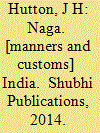

|
|
|
|
|
| Publication |
India, Shubhi Publications, 2014.
|
| Description |
71p.Hbk
|
| Standard Number |
9788182903173
|
|
|
|
|
|
|
|
|
|
|
|
Copies: C:1/I:0,R:0,Q:0
Circulation
| Accession# | Call# | Current Location | Status | Policy | Location |
| 059963 | 954.165/HUT 059963 | Main | On Shelf | General | |
|
|
|
|
| 14 |
ID:
064391


|
|
|
|
|
| Publication |
London, Marshall Cavendish Academic, 2005.
|
| Description |
xiv, 489p.pbk
|
| Standard Number |
9812103066
|
|
|
|
|
|
|
|
|
|
|
|
Copies: C:1/I:0,R:0,Q:0
Circulation
| Accession# | Call# | Current Location | Status | Policy | Location |
| 049872 | 959.054/SAV 049872 | Main | On Shelf | General | |
|
|
|
|
| 15 |
ID:
095812
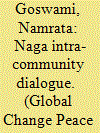

|
|
|
|
|
| Publication |
2010.
|
| Summary/Abstract |
The Naga intra-community dialogue is one of the most distinctive community-based dialogue processes in the world for the prevention, management and resolution of violent ethnic conflicts. Ongoing since the 1950s, the Naga dialogue has gained strong momentum since 2000 as a result of its growing capacity to address issues of violence and security in Naga-inhabited areas in India. The dialogue enjoys popular support as the formal ceasefire agreements between the Union Government and the Naga militant actors have failed to address issues of inter-factional violence and civilian deaths. The article argues that the Naga intra-community dialogue enjoys legitimacy in Naga society due to its representative character and visible impact in controlling the 'escalation' of violence in society. The article also argues that the formal Naga peace negotiations between the Government of India and the National Socialist Council of Nagalim-Isak-Muivah-NSCN (IM) will become more effective and inclusive in character if it is firmly rooted in the community based Naga dialogue.
|
|
|
|
|
|
|
|
|
|
|
|
|
|
|
|
| 16 |
ID:
117925
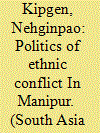

|
|
|
|
|
| Publication |
2013.
|
| Summary/Abstract |
This article analyses the conflict between the Kuki and Naga ethnic groups in the state of Manipur in North East India and attempts to understand why tensions arose in the first place and remain today between the two ethnic groups despite the formal cessation of hostilities in 1997. This ethnic conflict is shown to be a consequence of a lingering identity problem, aggravated by land disputes and equivocal responses of the state. It is argued that continued land disputes, the Nagas' unwillingness to perform Kuki customary rites and the government's indifference to the problem prevent these two groups from reaching a sustainable solution.
|
|
|
|
|
|
|
|
|
|
|
|
|
|
|
|
| 17 |
ID:
031779


|
|
|
|
|
| Publication |
Gauhati, United Publishers, 1976.
|
| Description |
xv, 164p.hbk
|
|
|
|
|
|
|
|
|
|
|
|
Copies: C:1/I:0,R:0,Q:0
Circulation
| Accession# | Call# | Current Location | Status | Policy | Location |
| 020534 | 954.03/BAR 020534 | Main | On Shelf | General | |
|
|
|
|
| 18 |
ID:
179524


|
|
|
|
|
| Summary/Abstract |
This study investigated the image of the Naga Indigenous people in mainland India and how the Nagas endeavour to develop an alternative image. Findings revealed that the mainland Indians’ image of the Nagas is that of ‘noble savage’ which is similar to the Indian Government’s representation of the Nagas as exotic and untamed. The Nagas expressed cultural resistance and articulated radical Naga discourse through their religion (Christianity) to enhance collective identity but most importantly to oppose the dominant Hindu and Muslim religions in mainland India. However, the resistance of the Nagas drew on Bhabha’s concept of hybridity in which the Nagas re-negotiate their identity – with complex mimicry and façade – traits about ‘Hindu-Muslim India’ that they admire and certain cultural aspects they ridicule and would rather not imbibe. This study contributes to the current anthropological discourse towards studying indigeneity by making a more complex, nuanced analysis of resistance.
|
|
|
|
|
|
|
|
|
|
|
|
|
|
|
|
| 19 |
ID:
128551
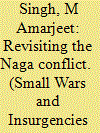

|
|
|
|
|
| Publication |
2013.
|
| Summary/Abstract |
Soon after India attained its independence from British colonial administration in 1947 the Nagas started waging an armed conflict against India to establish a sovereign independent state in Nagaland in the country's Northeast region. The conflict is today one of the world's longer running and little known armed conflicts. India's central government has tried unsuccessfully to tackle the problem through political reconciliation, use of force, and several development measures. Over the years, it has also undergone several changes in which the situation of conflict deepened whenever India's central government intervened. And yet, the road ahead also faces severe challenges because the demand for bringing the Nagas of India together into a single political entity will not go unchallenged from other ethnic groups. Moreover, a bitter leadership battle divides the Naga rebels and hence any future agreement is likely to be difficult due to factional politics as have happened in the past. Thus one way to satisfy the aspirations of different ethnic groups while protecting the boundaries of the existing states in India is to explore the option of cultural autonomy. This idea is not entirely new, but has lost significance over the years.
|
|
|
|
|
|
|
|
|
|
|
|
|
|
|
|
| 20 |
ID:
023963
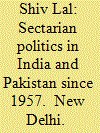

|
|
|
|
|
| Publication |
New Delhi, The Election Archivs, 1971.
|
| Description |
192p.hbk
|
|
|
|
|
|
|
|
|
|
|
|
Copies: C:1/I:0,R:0,Q:0
Circulation
| Accession# | Call# | Current Location | Status | Policy | Location |
| 008211 | 954.035/SHI 008211 | Main | On Shelf | General | |
|
|
|
|
|
|
|
|
|